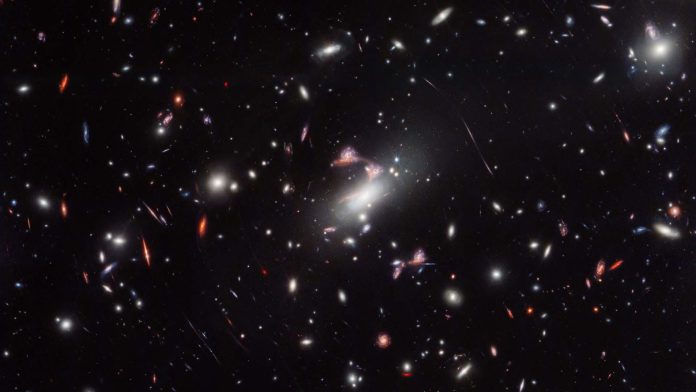Unveiling the Mysterious Cosmic Question Mark Captured by NASA’s James Webb Space Telescope
Have you ever looked up at the stars and wondered what’s really out there? Well, NASA’s James Webb Space Telescope just dropped a cosmic bombshell—capturing what looks like a gigantic question mark in the distant universe! This mysterious red galaxy has energized both scientists and space enthusiasts alike, igniting questions and speculation about its true nature.
H3: The Curious Discovery of a Cosmic Question Mark
The incredibly detailed image reveals a hazy red galaxy forming into the shape of a giant question mark, leaving many to ponder—what does it mean? The iconic NASA telescope utilized its powerful Near-Infrared Imager and Slitless Spectrograph to pinpoint this unusual phenomenon, leading to an array of hypotheses among astronomers and space fans.
Initially, the appearance of the question mark sparked wild theories of an alien civilization trying to reach out to us. Yet, NASA researchers offer a more scientific explanation: the phenomenon known as **gravitational lensing**.
H3: What is Gravitational Lensing?
Gravitational lensing is a fascinating effect where the gravity of an immensely massive object—in this instance, a galaxy cluster—bends light from objects located behind it. This bending of light can create stunning visual distortions, leading to the captivating cosmic configurations we’ve encountered.
What’s groundbreaking about this discovery is that this question mark shape was not visible even with previous observations from the Hubble Space Telescope. Thanks to Webb’s advanced capabilities, astronomers are now able to see details previously hidden, unveiling the incredible interplay of light and gravity in the universe.
H3: The Role of the MACS-J0417.5-1154 Galaxy Cluster
To fully comprehend the cosmic wonder that is the question mark, we need to turn our gaze towards the galaxy cluster MACS-J0417.5-1154. This colossal cluster has an uncanny ability to warp the fabric of space-time, considerably magnifying the view of galaxies positioned behind it.
The gravitational effects of this massive cluster don’t just enhance visibility; they also create distortions that multiply the appearance of these distant galaxies, much like looking through a warped glass. Among these is the recently captured red galaxy alongside another spiral galaxy previously identified by Hubble.
H3: Star Formation in Action: The Birth of Stars in Question Mark Pair
The intriguing part of this discovery doesn’t end with the question mark; scientists sought to understand how stars are formed within these distant galaxies. In essence, galaxies are colossal collections of gas, dust, and billions of stars—all held together by the omnipresent force of gravity.
What the data suggests is quite astonishing: active star formation is occurring in both the red galaxy shaped like a question mark and its spiral neighbor. Astronomer Vicente Estrada-Carpenter pointed out, “Both galaxies in the Question Mark Pair show active star formation in several compact regions, likely a result of gas from the two galaxies colliding.”
H3: Insights into Our Own Milky Way
Delving deeper into these cosmic interactions offers rare insights into our own Milky Way’s formative years. The galaxies observed here are akin in mass to the Milky Way billions of years ago, shedding light on how our celestial home may have evolved during its teenage years. These revelations are not only crucial for our understanding of the universe but also incredibly exciting for astronomers aiming to peer further back in time.
H3: Rare Gravitational Lens Configurations Awaiting Discovery
NASA scientists believe that the universe may hold numerous hidden gravitational lens configurations yet to be discovered. Currently, they are aware of only three or four similar occurrences, each providing a unique perspective on cosmic structure and formation. As technology evolves, who knows what other cosmic mysteries we’ll unveil!
H3: The James Webb Space Telescope: A Closer Look
Now, let’s take a moment to appreciate the technology that made this discovery possible: the **James Webb Space Telescope (JWST)**! Launched on December 25, 2021, JWST is designed to complement and extend the groundbreaking achievements of the Hubble Space Telescope, equipped with a larger primary mirror to catch fainter light from the universe’s early days.
Operating in the infrared spectrum, JWST allows us to peer through the dust clouds that obscure visible light. Positioned at the second Lagrange point (L2), approximately 1.5 million kilometers from Earth, this observatory provides an optimal environment for studying distant cosmic phenomena without interference.
With its scientific aspirations aimed at studying star and planet formation, investigating the evolution of galaxies, and exploring the potential for life in other parts of the universe, JWST is set to unravel secrets that have eluded us for decades.
Concluding Thoughts: What Lies Beyond Our Universe?
As we gaze at the cosmic question mark captured by the James Webb Space Telescope, we’re reminded of the limitless questions that arise when we contemplate our universe. The mysteries surrounding gravitational lensing and star formation are just pieces of a much larger cosmic puzzle. The telescope’s discoveries offer not only answers but also ignite our curiosity—an essential component of scientific exploration. Who can say what other astounding phenomena await as we continue to explore the vast, uncharted territories of our universe?

